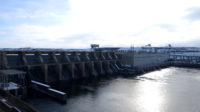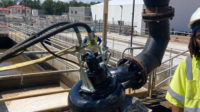At the Washington National Records Center in Suitland, Md., building systems from when it was constructed in 1967 are still in use. Government asset managers have sought funding for deferred maintenance and repair projects at the facility for more than 15 years, during which the building’s condition has worsened as funding fell short of what they sought. A temporary membrane was installed in 2012 to address roof leaks. The leaks caused mold, which cost $1.3 million to remediate in 2019. Now the membrane has reached the end of its useful life, and the entire roof needs replacement.
The facility exemplifies how deferred maintenance and repairs to federally owned buildings and other structures is adding billions of dollars to the eventual cost of the work, according to a report the U.S. Government Accountability Office (GAO) released Nov. 16. GAO’s study looked at estimates for deferred maintenance and repair for the Dept. of Energy (DOE), Dept. of Health and Human Services (HHS), Dept. of the Interior (DOI) and General Services Administration (GSA) between 2017 and 2022.
Delays caused by funding shortages have exacerbated some problems, according to GAO. Some items planned for repairs have instead required replacements. Estimated costs to cover the backlog of deferred projects increased by about $22 billion between the four agencies during the five-year span.
As of last year, the four federal agencies were together responsible for a portfolio of about 58,000 buildings and 96,000 other structures. Officials at the agencies attributed an 80% increase in the estimated cost of their backlogs to a mix of funding constraints, cost increases and age of their assets. The increases ranged from 63% at DOE to 126% at GSA during the period, according to the report.
While cost estimates have increased, available maintenance and repair funding has remained relatively constant. GSA officials said their budget for repair and alteration projects have fallen short of requested funding for more than 10 years. GAO estimates inflation eroded the agencies’ maintenance and repair purchasing power by 26% during the period.
The age of some structures complicates and adds to the cost of their maintenance. DOI’s Bureau of Reclamation manages the Grand Coulee Dam in Washington state, and officials noted that its maintenance requires parts for equipment that is no longer manufactured.
Recent legislation like the Infrastructure Investment and Jobs Act of 2021 and Inflation Reduction Act of 2022 have partially helped the situation. For example, GSA was able to put part of the $89.8 million it received through IIJA and $121.8 million it received through IRA toward reducing its $3.1-billion backlog. However, officials note funding from the two acts comes with limitations on how it can be spent.
GAO offered recommendations to the agencies, such as developing plans to address their backlogs and providing more information on the needed work in their budget materials to Congress. In comments responding to a draft of the report, officials from GSA, DOI and HHS agreed to develop plans implementing the recommendations. DOE officials wrote that they would establish a working group to examine the recommendations.






Post a comment to this article
Report Abusive Comment